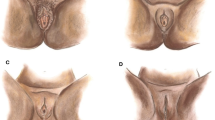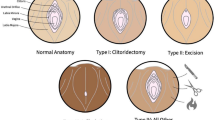Abstract
The Female Genital Mutilation Act (2003) in England allows for mental health exceptions for cosmetic surgery resulting from perceived abnormality. Similar legislation exists in other countries. There are no reported cases of clitoridectomy for cosmetic reasons or any discussion in the literature of mental health exceptions to the Act. This is a single case report on a 33-year-old married, heterosexual woman who had already had a cosmetic labiaplasty and was seeking a clitoridectomy for aesthetic reasons. At assessment, there were no psychiatric contra-indications or unrealistic expectations and the patient proceeded with a clitoridectomy. At 9 and 22 months follow-up, she was reassessed and was very pleased with the outcome. There were improvements in the satisfaction with her genital appearance, sexual satisfaction, and quality of life related to body image. Assessments for cosmetic clitoridectomy will continue to be rare, but this case may provide some guidance for practitioners who are confronted with such requests for body modification. However there remains only limited understanding of the motivation for such a request.
Similar content being viewed by others
References
Beauchamp, T. L., & Childress, J. F. (2008). Principles of biomedical ethics (6th ed.). New York: Oxford University Press.
Bramwell, R., & Morland, C. (2009). Genital appearance satisfaction in women: The development of a questionnaire and exploration of correlates. Journal of Reproductive and Infant Psychology, 27, 15–27.
Bramwell, R., Morland, C., & Garden, A. S. (2007). Expectations and experience of labial reduction: A qualitative study. BJOG: An International Journal of Obstetrics and Gynaecology, 114, 1493–1499.
Cartwright, R., & Cardozo, L. (2008). Cosmetic vulvovaginal surgery. Obstetrics, Gynaecology and Reproductive Medicine, 18, 285–286.
Cash, T. F., & Fleming, E. C. (2002). The impact of body-image experiences: Development of the Body Image Quality of Life Inventory. International Journal of Eating Disorders, 31, 455–460.
Castle, D. J., Honigman, R. J., & Phillips, K. A. (2002). Does cosmetic surgery improve psychosocial well-being? Medical Journal of Australia, 176, 601–604.
First, M. B. (2005). Desire for amputation of a limb: Paraphilia, psychosis, or a new type of identity disorder. Psychological Medicine, 35, 919–928.
Furth, G. M., & Smith, R. (2000). Apotemnophilia: Information, questions, answers, and recommendations about self-demand amputation. Bloomington, IN: 1st Books.
Goodman, M. P. (2009). Female cosmetic genital surgery. Obstetrics and Gynecology, 113, 154–159.
Home Office. (2002). Female Genital Mutilation Bill Explanatory notes. Bill 21-EN House of Commons.
Home Office. (2005). Explanatory notes to prohibition of female genital mutilation (Scotland) Act 2005. London: The Stationery Office Limited.
Krasucki, C., Kemp, R., & David, A. (1995). A case of female genital self-mutilation in schizophrenia. British Journal of Medical Psychology, 68, 179–186.
Lambrou, C., Veale, D., & Willson, G. (2011). The role of aesthetic sensitivity in body dysmorphic disorder. Journal of Abnormal Psychology, 120, 443–453.
Lawrence, A. A. (2010). Desire for castration is not a body integrity identity disorder: Comment on Johnson et al. (2007), Brett et al. (2007), and Roberts et al. (2008). Journal of Sexual Medicine, 7, 852–855.
Lemma, A. (2010). Under the skin: A psychoanalytic study of body modification. London: Routledge.
Liao, L. M., & Creighton, S. M. (2007). Requests for cosmetic genitoplasty: How should healthcare providers respond? British Medical Journal, 334, 1090–1092.
Office of Public Sector Information. (2003). Female Genital Mutilation Act. London: Home Office.
Phillips, K. A., & Dufresne, R. G. (2000). Body dysmorphic disorder: A guide for dermatologists and cosmetic surgeons. American Journal of Clinical Dermatology, 1, 235–243.
Phillips, K. A., Hollander, E., Rasmussen, S. A., Aronowitz, B. R., DeCaria, C., & Goodman, W. K. (1997). A severity rating scale for body dysmorphic disorder: Development, reliability, and validity of a modified version of the Yale-Brown Obsessive Compulsive scale. Psychopharmacology Bulletin, 33, 17–22.
Rogers, R. G., Kammerer-Doak, D., Villarreal, A., Coates, K., & Qualls, C. (2001). A new instrument to measure sexual function in women with urinary incontinence or pelvic organ prolapse. American Journal of Obstetrics and Gynaecology, 184, 552–558.
Sarwer, D. B., Wadden, T. A., & Pertshuk, M. J. (1998). The psychology of cosmetic surgery: A review and reconceptualization. Clinical Psychology Review, 18, 1–22.
Semiz, U., Basoglu, C., Cetin, M., Ebrinc, S., Uzun, O., & Ergun, B. (2008). Body dysmorphic disorder in patients with borderline personality disorder: Prevalence, clinical characteristics, and role of childhood trauma. Acta Neuropsychiatrica, 20, 33–40.
Simeon, D., Favazza, A., Simeon, D., & Hollander, E. (2001). Self-injurious behaviours: Phenomenology and assessment. In D. Simeon & E. Hollander (Eds.), Self-injurious behaviours: Assessment and treatment (pp. 1–28). Washington, DC: American Psychiatric Press.
Veale, D. (2000). Outcome of cosmetic surgery and ‘DIY’ surgery in patients with body dysmorphic disorder. Psychiatric Bulletin, 24, 218–221.
Veale, D. (2006). A compelling desire for deafness. Journal of Deaf Studies and Deaf Education, 11, 369–372.
Veale, D., Gournay, K., Dryden, W., Boocock, A., Shah, F., Willson, R., et al. (1996). Body dysmorphic disorder: A cognitive behavioural model and a pilot randomised controlled trial. Behaviour Research and Therapy, 34, 717–729.
Veale, D., & Neziroglu, F. (2010). Body dysmorphic disorder: A treatment manual. Chichester: Wiley Sons.
Wise, T. N., Dietricha, M., & Segalle, E. (1989). Female genital self-mutilation: Case reports and literature review. Journal of Sex and Marital Therapy, 15, 269–274.
Author information
Authors and Affiliations
Corresponding author
Rights and permissions
About this article
Cite this article
Veale, D., Daniels, J. Cosmetic Clitoridectomy in a 33-Year-Old Woman. Arch Sex Behav 41, 725–730 (2012). https://doi.org/10.1007/s10508-011-9831-4
Received:
Revised:
Accepted:
Published:
Issue Date:
DOI: https://doi.org/10.1007/s10508-011-9831-4




